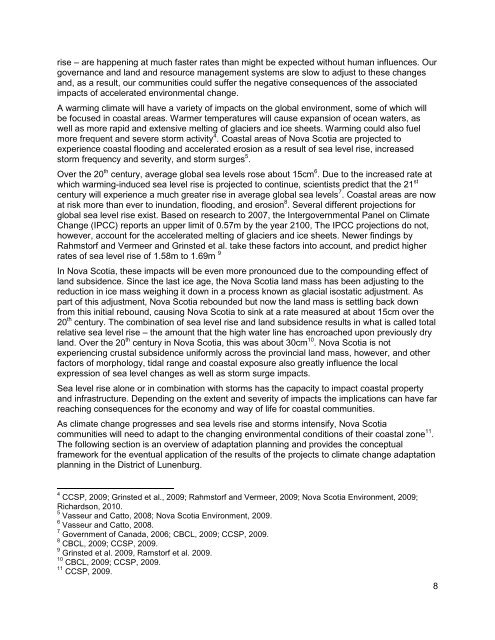Lunenburg Part 1 - Introduction and Background August 30.pdf
Lunenburg Part 1 - Introduction and Background August 30.pdf
Lunenburg Part 1 - Introduction and Background August 30.pdf
You also want an ePaper? Increase the reach of your titles
YUMPU automatically turns print PDFs into web optimized ePapers that Google loves.
ise – are happening at much faster rates than might be expected without human influences. Our<br />
governance <strong>and</strong> l<strong>and</strong> <strong>and</strong> resource management systems are slow to adjust to these changes<br />
<strong>and</strong>, as a result, our communities could suffer the negative consequences of the associated<br />
impacts of accelerated environmental change.<br />
A warming climate will have a variety of impacts on the global environment, some of which will<br />
be focused in coastal areas. Warmer temperatures will cause expansion of ocean waters, as<br />
well as more rapid <strong>and</strong> extensive melting of glaciers <strong>and</strong> ice sheets. Warming could also fuel<br />
more frequent <strong>and</strong> severe storm activity 4 . Coastal areas of Nova Scotia are projected to<br />
experience coastal flooding <strong>and</strong> accelerated erosion as a result of sea level rise, increased<br />
storm frequency <strong>and</strong> severity, <strong>and</strong> storm surges 5 .<br />
Over the 20 th century, average global sea levels rose about 15cm 6 . Due to the increased rate at<br />
which warming-induced sea level rise is projected to continue, scientists predict that the 21 st<br />
century will experience a much greater rise in average global sea levels 7 . Coastal areas are now<br />
at risk more than ever to inundation, flooding, <strong>and</strong> erosion 8 . Several different projections for<br />
global sea level rise exist. Based on research to 2007, the Intergovernmental Panel on Climate<br />
Change (IPCC) reports an upper limit of 0.57m by the year 2100, The IPCC projections do not,<br />
however, account for the accelerated melting of glaciers <strong>and</strong> ice sheets. Newer findings by<br />
Rahmstorf <strong>and</strong> Vermeer <strong>and</strong> Grinsted et al. take these factors into account, <strong>and</strong> predict higher<br />
rates of sea level rise of 1.58m to 1.69m 9<br />
In Nova Scotia, these impacts will be even more pronounced due to the compounding effect of<br />
l<strong>and</strong> subsidence. Since the last ice age, the Nova Scotia l<strong>and</strong> mass has been adjusting to the<br />
reduction in ice mass weighing it down in a process known as glacial isostatic adjustment. As<br />
part of this adjustment, Nova Scotia rebounded but now the l<strong>and</strong> mass is settling back down<br />
from this initial rebound, causing Nova Scotia to sink at a rate measured at about 15cm over the<br />
20 th century. The combination of sea level rise <strong>and</strong> l<strong>and</strong> subsidence results in what is called total<br />
relative sea level rise – the amount that the high water line has encroached upon previously dry<br />
l<strong>and</strong>. Over the 20 th century in Nova Scotia, this was about 30cm 10 . Nova Scotia is not<br />
experiencing crustal subsidence uniformly across the provincial l<strong>and</strong> mass, however, <strong>and</strong> other<br />
factors of morphology, tidal range <strong>and</strong> coastal exposure also greatly influence the local<br />
expression of sea level changes as well as storm surge impacts.<br />
Sea level rise alone or in combination with storms has the capacity to impact coastal property<br />
<strong>and</strong> infrastructure. Depending on the extent <strong>and</strong> severity of impacts the implications can have far<br />
reaching consequences for the economy <strong>and</strong> way of life for coastal communities.<br />
As climate change progresses <strong>and</strong> sea levels rise <strong>and</strong> storms intensify, Nova Scotia<br />
communities will need to adapt to the changing environmental conditions of their coastal zone 11 .<br />
The following section is an overview of adaptation planning <strong>and</strong> provides the conceptual<br />
framework for the eventual application of the results of the projects to climate change adaptation<br />
planning in the District of <strong>Lunenburg</strong>.<br />
4 CCSP, 2009; Grinsted et al., 2009; Rahmstorf <strong>and</strong> Vermeer, 2009; Nova Scotia Environment, 2009;<br />
Richardson, 2010.<br />
5 Vasseur <strong>and</strong> Catto, 2008; Nova Scotia Environment, 2009.<br />
6 Vasseur <strong>and</strong> Catto, 2008.<br />
7 Government of Canada, 2006; CBCL, 2009; CCSP, 2009.<br />
8 CBCL, 2009; CCSP, 2009.<br />
9 Grinsted et al. 2009, Ramstorf et al. 2009.<br />
10 CBCL, 2009; CCSP, 2009.<br />
11 CCSP, 2009.<br />
8














